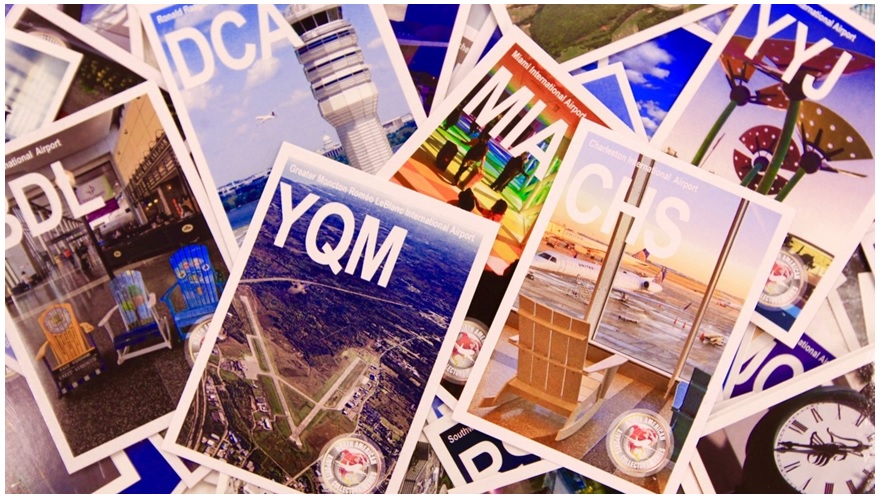
Airport Trading Cards: A New Dimension in Travel Memorabilia
Traveling is not just about reaching a destination; it’s about the experiences and memories we collect along the way. In recent years, a unique form of memorabilia has been gaining popularity among travelers and aviation enthusiasts: airport trading cards. These collectible trading cards add an exciting layer to the travel experience, offering a tangible piece of each journey and a new hobby for collectors.
The Origin and Evolution of Airport Trading Cards
The concept of airport trading cards was first introduced in 2014 by the North American Airports Collectors Series (NAACS), an initiative of the Airports Council International – North America (ACI-NA). The program was conceived as a way for airports to highlight their unique attributes, from architectural features and historical significance to their impact on local communities.
The idea initially faced skepticism, but soon gained traction as airports recognized the potential to engage with travelers and aviation enthusiasts in a novel way. What started as a small project has now grown into a widely embraced campaign, with nearly 80 U.S. and Canadian airports participating and a dedicated following of collectors.
Collecting Airport Trading Cards: A Traveler’s Delight
Airport trading cards are usually available for free at information booths within participating airports. Each card is distinct, often featuring the airport’s IATA code, stunning imagery of the airport, and interesting facts or historical tidbits on the reverse side. From pictures of gleaming terminal atriums to aerial shots of runways, these cards capture the essence of each airport.
Obtaining these cards can sometimes be a challenge, adding to their allure. Availability varies from airport to airport, and not all staff members may be aware of the program. In some cases, enthusiasts have turned to social media to request cards or even received them via mail. This varying availability has created a sense of adventure and challenge, further fueling the enthusiasm for collecting these unique items.
Beyond Collecting: Connecting with Airport Histories and Communities
More than just collectibles, these trading cards serve as educational tools, providing insights into each airport’s history, economic impact, and cultural significance. They offer a window into the world of aviation and the vital role airports play in connecting people and places. As such, they are more than mere souvenirs; they are storytellers, each card a chapter in the vast narrative of global travel and connectivity.
The Future of Airport Trading Cards
As the popularity of airport trading cards continues to grow, they are becoming more than just a hobby; they are a testament to the ever-evolving culture of travel. They represent a unique intersection between aviation, art, and storytelling, encapsulating the spirit of exploration and discovery that lies at the heart of every journey.
Does American Airlines Have Trading Cards?
Yes, American Airlines does have trading cards. There are several sets available for purchase, such as the American Airlines Trading Cards Boeing 737-800 set, which includes 50 cards, and the American Airlines Trading Cards Airbus A319, also a set of 50 cards. Additionally, there are collector trade cards available which feature elements of airline history, like the DC-3 and C.R. Smith.
Today, trading cards can be found on eBay and are being sold by various sellers. The condition of the cards ranges from new to used, and the prices vary depending on the set and condition. Shipping details and return policies are specific to each seller.
Key Takeaways
- Airport trading cards originated in 2014 as a way for airports to highlight their unique attributes and engage with travelers.
- Nearly 80 U.S. and Canadian airports now participate in issuing free trading cards.
- The cards feature images of the airport and interesting facts, capturing the essence of each location.
- Collecting the cards has become an adventurous hobby for travelers and aviation enthusiasts.
- The varying availability of the cards at each airport has added to their collectible appeal.
- The cards provide educational insights into the history and significance of each airport.
- Airport trading cards represent the intersection of aviation, art, and storytelling in the evolving culture of travel.
Airport trading cards offer a fresh and exciting way to commemorate travels. For the avid collector, each card is a trophy, a memento of a journey taken and a reminder of the vast, interconnected world we live in. As this trend continues to spread across North America, it brings with it the promise of new discoveries, not just in distant lands, but in the airports that serve as gateways to these adventures.
What do airport trading cards display?
Airport trading cards usually display stunning and vibrant imagery of the airport such as terminal architecture, aerial runway views, etc. Additionally, the reverse side features interesting facts, figures, and historical tidbits unique to that airport. For instance, a card might showcase when the first flight took off, its economic impact on the city, the IATA airport code, famous visitors over the years, or little-known quirks about its design. Essentially, they encapsulate visuals and information about the airport’s operations, history, and uniqueness.
Where can you obtain airport trading cards?
Airport trading cards are usually available for free at information desks and booths within the terminals of participating airports. However, availability can vary widely depending on staff knowledge and quantities in stock so they can sometimes be challenging to obtain. Enthusiasts have been known to request cards through social media channels or even receive them in the mail in some dedicated cases. The varying availability itself has added to the appeal and adventure of collecting what has turned into an exciting hobby.
How did airport trading cards evolve from skepticism to mass participation?
When airport trading cards were first introduced by the North American Airport Collectors Series (NAACS) in 2014, the idea faced initial skepticism about whether there would be any interest in such memorabilia. However, airports soon realized their potential as educational tools to highlight histories, impacts, architecture and the role of aviation. They offered a new avenue to engage with travelers. From modest beginnings, participation grew from a handful of airports to nearly 80 across the US and Canada today with dedicated collectors emerging. What began as a small project turned into a widely popular initiative.
Why are airport trading cards about more than just collecting?
Airport trading cards provide insights into the historical and cultural narratives of not just airports but the communities they serve. Each card tells a part of the story linking global air travel with local economic impacts. Enthusiasts derive educational benefits across aviation, geography, architecture and other fields while also feeling connected to the spirit of travel. The cards represent little chapters about humanity’s quest to discover places, people and cultures. More than mere souvenirs, they encapsulate airports’ vital role in this endeavor.
What does the future likely hold for airport trading cards?
Considering growing enthusiasm among travelers and aviation aficionados, airport trading cards are poised to increase in popularity over the coming years. More airports can be expected to join the nearly 80 already participating to produce their own unique cards. The intersection of travel, art, culture and storytelling manifest through these cards is deepening further. As the culture around conscious, meaningful travel evolves, airport trading cards are becoming representations of those journeys – encapsulations of the spirit behind discovering new places and broadening one’s horizons. Their appeal is expected to cross over beyond just collectors.





